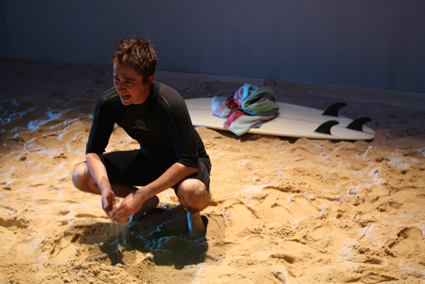dark inheritance
caroline wake: tantrum theatre, blackrock

Dean Blackford, Blackrock, Tantrum Theatre
photo Tom Potter
Dean Blackford, Blackrock, Tantrum Theatre
WHEN MY FAMILY MOVED FROM CANADA TO AUSTRALIA IN 1990 WE WONDERED WHERE ON EARTH WE HAD LANDED. THE NEWCASTLE HERALD SEEMED TO REPORT ONLY TWO EVENTS: THE NEWCASTLE EARTHQUAKE (DECEMBER 1989) AND THE MURDER OF LEIGH LEIGH (NOVEMBER 1989).
Recently I had a chance to revisit the latter when I went to see Tantrum Theatre’s new production of Nick Enright’s play Blackrock. Enright first wrote the play Property of the Clan for Freewheels theatre-in-education company in 1992 before redrafting it as Blackrock for the Sydney Theatre Company in 1995. You might also have seen the 1997 movie directed by Steven Vidler. The Tantrum production is essentially the 1995 version, albeit with a few minor updates to include references to champion surfer Layne Beachley instead of Wendy Botha.
As we enter the space, a theatre with roughly 200 steeply raked seats, we see a trapezoidal stage covered in sand. Depending on the lighting (John Zeder), it looks like a beach, a bumpy relief map or a lumpy living room carpet. In the centre there’s a surfboard while up to the left a boy sits on a scaffold, dangling his legs. It’s Jared, enjoying the scenery before his cousin Cherie comes to pester him for a surfing lesson. From here, Blackrock follows a fairly classical narrative structure of exposition, complication, crisis and resolution. In the expository stages, we meet Jared, his mother Diane, his girlfriend Rachel and her family. We also meet his other ‘family,’ the surfing community at Blackrock. When their paterfamilias, Ricko, returns from some sort of safari, a party is in order. During the party, which is low on adults and high on alcohol, a girl named Tracy Warner is raped and murdered. The remainder of the play deals with the aftermath.
Sociologist Kai Erikson argues that trauma has both a centripetal and a centrifugal force within a community (A New Species of Trouble, WW Norton, 1994). On the one hand, it can cause existing divisions to widen. In Blackrock, the community splits along lines of class (the middle class perpetrator has access to a proper lawyer, the two working class accused are presumably left to Legal Aid), gender (the girls are deeply upset, the boys attempt to carry on as usual) and generation (neither the parents nor their children can comprehend each other’s actions and reactions). On the other hand, trauma can also cause communities to band together. This occurs in Blackrock to ethically ambiguous effect: in their efforts to comfort and reassure one another, the young men are soon colluding, coming up with alibis and agreeing to back each other up.
Director Brendan O’Connell draws subtle and nuanced performances from almost all of his cast. The young women effectively portray the febrile and slightly hysterical emotion of teenagers: they sob, stalk, whimper and sometimes shout. Brittany Turner is an endearing Cherie, making light work of monologues that are often tortured in drama classes. Likewise, Sarah Coffee is suitably highly-strung as Tiffany and Rachel Jackett is disarmingly low key as Rachel. The young men in the cast also manage to convey the excitement, terror and inarticulate rage their characters feel. Dean Blackford is especially sympathetic as Jared. The adults are also good: Karen Lantry deserves a special mention for her portrayal of Jared’s mother, who emerges as tough but tender, as does Cheryl Sovechles for her depiction of her vivacious sister Glenys. The characters’ moods are ably amplified by Kieran Norman’s sound design and Zackari Watt’s compositions: arguments are underscored by dissonance, points of shock by staccato notes and the music speeds up and slows down with the dialogue.
In the final scene, Jared finally cracks and admits that he saw the entire incident but did not go to Tracy’s aid. It is a melodramatic and somewhat problematic moment. For the character, it is the moment of confession, remorse and regret for his part in this moral mess. For the audience, however, it functions as a sort of reveal, as we finally find out what actually happened. In this sense, the play provides its spectators with a sense of closure that the community itself has never and probably can never experience.
“No one has ever worked through an injury without repeating it,” writes Judith Butler, “[t]here is not possibility of not repeating. The only question that remains is: How will that repetition occur, at what site…and with what pain or promise?” (Excitable Speech, Routledge, 1997). What, then, is the point and purpose of restaging Blackrock 20 years after the events that inspired it? For a young director, perhaps it is a chance to test himself against an Australian classic. Indeed, it is a chance to test the classic itself. For spectators who, like me, were there when the events transpired, the performance provides us with the time and space to do memory work, to wonder if that’s how it really happened and think about what has transpired in the interim. Finally, for the young actors themselves, performing in Blackrock might be likened to one of the play’s many initiation ceremonies (Toby turning 18, his sister Rachel dating her first boyfriend, and his mother writing on Indigenous initiations). To perform in Blackrock is to be initiated into Newcastle’s history, to learn that along with the mines and the beaches, the death of Leigh Leigh too is your ambivalent inheritance.
Tantrum Theatre, Blackrock, writer Nick Enright, director, designer Brendan O’Connell, performers Rod Ansell, Dean Blackford, Sarah Coffee, Ben Freeman, Erika Gelzinnis, Cordelia Hamilton-Russell, Steffen Hesping, Rachel Hackett, Dean Johnson, Karen Lantry, Bradley McDonald, Cheryl Sovechles, Brittany Turner, Daniel Yaxley, lighting designer John Zeder, composer Zackari Watt, sound designer Kieran Norman; The Playhouse, Civic Theatre, Newcastle, May 13-22, www.tantrumtheatre.org.au
RealTime issue #98 Aug-Sept 2010 pg. 6






